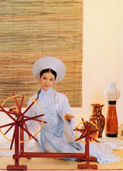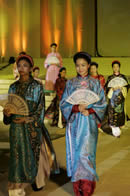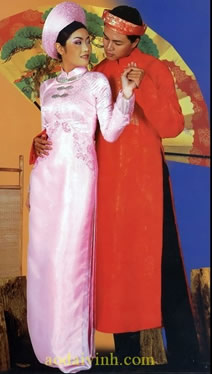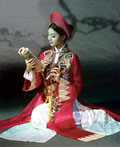INTRODUCTION
The Áo Dài, literally meaning "long dress" or "long tunic," is one out of several traditional Vietnamese costumes worn (nowadays) primarily by women. It is the most popular national costume in Vietnam.
HISTORY
Pronounced 'Ao Yai' in the south, and 'Ao Zai' in the north, the costume has had a short history relative to the country and people of Vietnam.
Early versions of the Ao Dai date back to the early 1700's, and were influenced by Chinese Imperial garb of the Qing dynasty, known as Qipao.
The costume has faced countless modifications throughout the centuries but its basic form consists of a long flowing gown with a slit on both sides, often with a high fitted collar, worn over long silk pants.
While its cousin the Qipao is a tight fitted dress (in its modern reincarnation), the Ao Dai is a looser tunic, which even in its tight-fitting form is still left wide and flowing at the bottom. Furthermore, the slits of the Ao Dai extend above the waistline, revealing a slight glimpse of the sides of the midriff.
Some historians have suggested that the Ao Dai was an evolution of different influences from many directions, including the indigenous 4-flapped tunic, or Ao Tu Than (Áo Tu Thân), one of the other more well known (and much older than Ao Dai) traditional Kinh costumes.
THE ORIGINAL AO DAI, or AO NGU THAN
While the indigenous Ao Tu Than costume (which existed for at least a thousand years in Vietnamese society) is viewed as having a large hand in the design of the Ao Dai, the closest form to the Ao Dai we know today made its first true appearance as the Ao Ngu Than or "5 part dress".
This "Ao Ngu Than" tended to be much looser fitting in general, sometimes designed with wide sleeves. In the past, rich Vietnamese often displayed their prosperity through clothing, often by wearing many layers at once. Some aristocrats were known to wear 3-5 layers of Ao Dai at one time!
The Ao Ngu Than had a major difference from the modern Ao Dai in the way it was made. 1800's Ao Ngu Than were made of 5 parts (hence its name). This consisted of two flaps sewn together in the back, two flaps sewn together in the front, and a fifth flap hidden underneath the front main flap. This 5-part Ao Dai was still similar to its current incarnation in that it was still a two-flapped tunic with slits on both sides, but the front and back flap were generally much broader, and of course the dress was much more loosely fit.
The high collar, buttoned in the same fashion as modern Ao Dai was still intact, but women could also wear the dress with the first few buttons undone, revealing a glimpse of the yem bodice underneath.
MODERIZATION
In 1930, the Vietnamese fashion designer Cat Tuong, known to the French as Monsieur Le Mur, modified it. He lengthened the Ao Dai so that the top reached the floor, and made it fit the curves of the body closer. With the import of an abundance of foreign fabrics in 20th century Vietnam, including broader fabric, the modernized Ao Dai only required 2 parts to be made, unlike its 5 part predecessor. As a result the flaps also became generally slimmer.
In Saigon during the 1950s, Tran Kim of Thiet Lap Tailors and Dung of Dung Tailors modified the Ao Dai to a form closest to what is seen today. He produced the gowns with raglan sleeves, creating a diagonal seam that runs from the collar to the underarm.
Ao Dai only continued to become more form-fitting with time.
In the 1960's the collarless Ao Dai style was popularized by the infamous Madame Nhu (former first lady of South Vietnam).
Despite the two major modifications to the Ao Dai in the 20th century, it has also seen slight changes throughout each decade as fashion changes constantly. Everything from floral to checkered patterns, the use of transparent fabrics, the tunic length being largely reduced or lengthened, etc. - has been seen throughout different eras of Vietnamese history.
The Ao Dai has always been more prevalent in the south than in the north, and has faced a surge in popularity in recent years, even with overseas Vietnamese.
In recent decades it has inspired worldwide renowned fashion designers such Ralph Lauren, among other big names, to create entire collections of Ao Dai.
The most popular style of the Ao Dai as we see it today is tight-fitting around the wearer's upper torso, emphasizing her bust and curves. For this reason, the Ao Dai, while it covers the whole body, is said to be provocative, especially when it is made of thin or see-through fabric.
THE ROYAL/ WEDDING AO DAI: AO MENH PHU
The royal costume most commonly known today would be the "Ao Menh Phu" of the Nguyen dynasty. It is predictably more festive (in color and decoration) and includes a long flowing outer robe (with large, wide sleeves).
This costume, once mandatory for royal women of the Nguyen dynasty to wear at public functions, has subsequently become the mandatory costume for Vietnamese brides.
In addition, brides often wear a Khan Dong (Khan Ðong), a crown-like headgear which is made from silk brocade.
THE AO DAI and ITS PLACE IN MODERN-DAY VIETNAM
Although it disappeared somewhat for a short period due to the extravagance and elegance of the costume being seen as an excess, it has surprisingly come back with a vengeance both for Vietnamese in Vietnam and overseas.
In addition to being worn at traditional and festive occasions, plain white Ao Dai is the uniform for female students in many Vietnamese high schools and some universities. Many companies also require their female staff to be attired in the Ao Dai.





